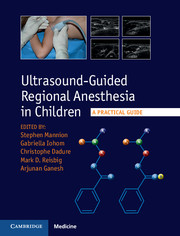Book contents
- Frontmatter
- Contents
- List of contributors
- 1 Introduction
- Section 1 Principles and practice
- 2 Performance of regional anesthesia in children
- 3 Pharmacology of local anesthetics in children
- 4 Management of complications of regional anesthesia
- 5 Basics of ultrasonography for regional anesthesia in children
- 6 Anatomy of the neuraxis, thoracic and abdominal walls, upper and lower limbs
- Section 2 Upper limb
- Section 3 Lower limb
- Section 4 Truncal blocks
- Section 5 Neuraxial blocks
- Section 6 Facial blocks
- Appendix: Muscle innervation, origin, insertion, and action
- Index
- References
3 - Pharmacology of local anesthetics in children
from Section 1 - Principles and practice
Published online by Cambridge University Press: 05 September 2015
- Frontmatter
- Contents
- List of contributors
- 1 Introduction
- Section 1 Principles and practice
- 2 Performance of regional anesthesia in children
- 3 Pharmacology of local anesthetics in children
- 4 Management of complications of regional anesthesia
- 5 Basics of ultrasonography for regional anesthesia in children
- 6 Anatomy of the neuraxis, thoracic and abdominal walls, upper and lower limbs
- Section 2 Upper limb
- Section 3 Lower limb
- Section 4 Truncal blocks
- Section 5 Neuraxial blocks
- Section 6 Facial blocks
- Appendix: Muscle innervation, origin, insertion, and action
- Index
- References
Summary
Introduction
Regional anesthesia has been shown to have a number of benefits including a reduction in stress response and inflammation, reduced opioid consumption and related side effects, and better post-operative analgesia (Roberts, 2006).
The use of local anesthetic (LA) is a prerequisite for successful nerve blockade; however, adverse outcomes such as prolonged neural blockade and systemic LA toxicity (LAST) may occur.
The safe performance of regional anesthesia requires a thorough knowledge and understanding of LA pharmacology. There are a number of important pharmacologic properties of LAs in pediatric patients, especially neonates and infants (<1 year of age) that differ from the adult patient.
This chapter will highlight these important differences, as well as the basic principles of LA pharmacology.
Mechanism of action (pharmacodynamics)
LAs exist in two forms, ionized hydrophilic (BH+) and non-ionized lipophilic (B). The non-ionized lipophilic form passes through the hydrophobic cell membrane rapidly. Once in the cytoplasm, the non-ionized and ionized fractions reach equilibrium (B + H+ ⇌ BH+). The ionized fraction is active and binds to the membrane-bound, voltage-gated sodium channels involved in the propagation of signaling. The sodium channel exists in one of three conformational states. The channel is closed when “resting” or “inactivated,” and open when “activated.” The membrane potential affects the conformational state, with depolarization leading to more open channels. LAs have a greater affinity for the sodium channel when it is in the “activated” conformation; thus, when nerve signals fire more frequently, LA affinity for the sodium channel increases. This results in an increased portion of blocked channels (Figure 3.1).
The channels become activated after chemical, mechanical, or electrical stimuli (i.e. pain impulse). As sodium ions enter into the cell an action potential is generated that is conducted as a nerve impulse (Figure 3.2). LAs bind and inhibit the sodium channels From inside the cell via reversible ionic interactions with the alpha subunit of the sodium channel. It is the ionized fraction that binds with higher affinity and dissociates from the channel subunit at a slower rate. This prevents cell membrane depolarization by blocking sodium ions from entering into the cell and preventing the channel from changing its conformation. The resulting interruption of signal conduction blocks pain transmission and can also lead to motor blockade.
- Type
- Chapter
- Information
- Ultrasound-Guided Regional Anesthesia in ChildrenA Practical Guide, pp. 13 - 19Publisher: Cambridge University PressPrint publication year: 2015



